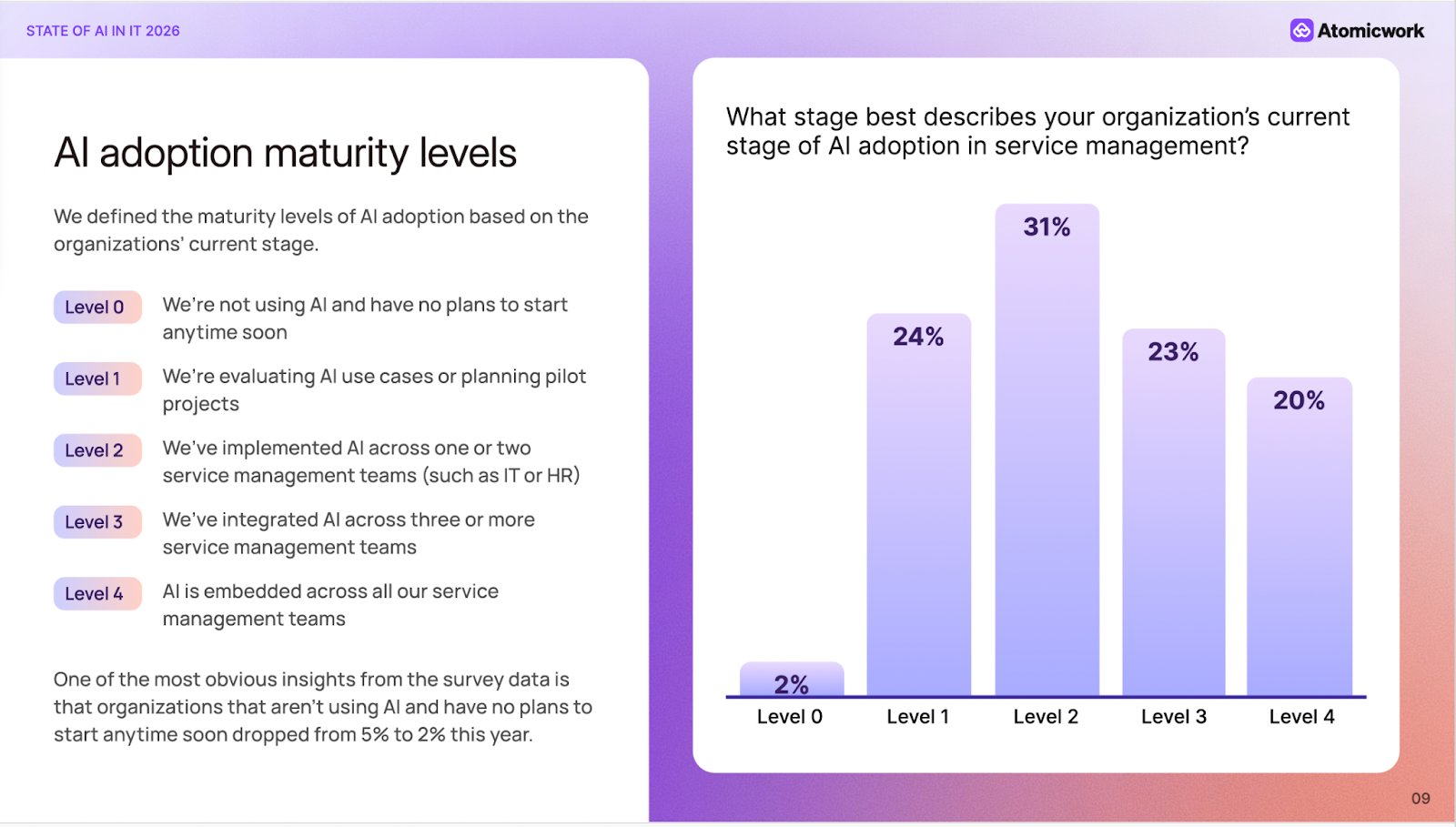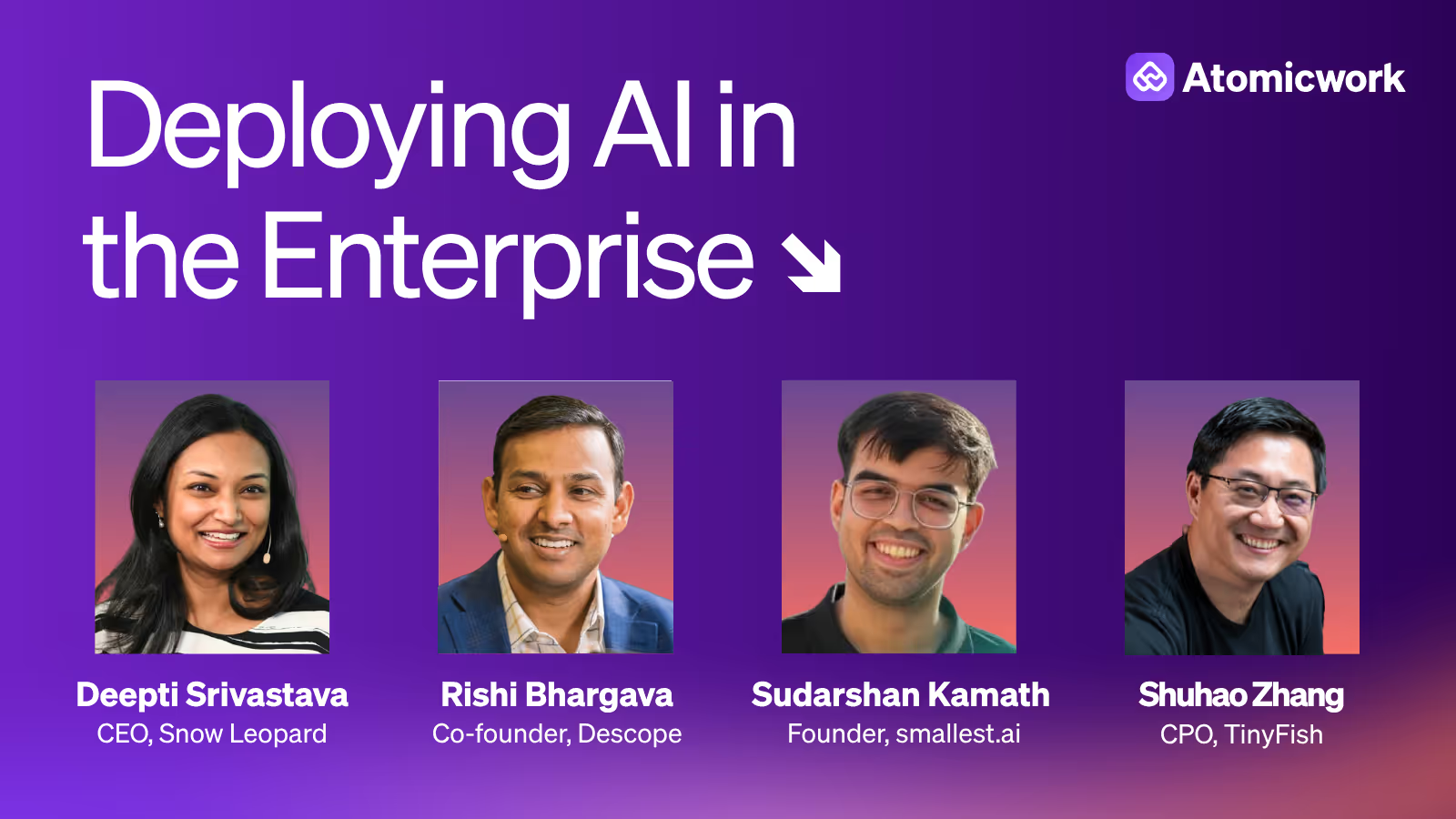How IT leaders should build an AI strategy for 2026

There is no doubt that AI is already everywhere in IT. However, the real question in 2026 is whether it’s actually working at scale.
According to our State of AI in IT 2026 report, most organizations have moved past early adoption. Many IT teams are using AI in production and reporting measurable value, yet only a small minority describe their AI programs as fully mature and integrated across functions. The gap between adoption and scale points to a hard truth: AI without strategy is still just experimentation.
Deloitte’s State of Generative AI in the Enterprise pulse surveys show that while most organizations are actively investing in AI, a significant majority report that 30% or fewer of their experiments are expected to be fully scaled in the near term, highlighting a persistent gap between experimentation and enterprise-wide impact. Adoption is common, but coordinated, scaled execution remains a challenge for many leaders.
In this guide, we outline what it takes to build an effective AI strategy for IT in 2026 so that you can move beyond pilots and deliver durable impact.

1. Start with a clear assessment of AI readiness
Before defining an AI strategy, IT leaders need an honest view of where their organization actually stands. In 2026, AI readiness is not a yes-or-no question. It exists across clear maturity levels, shaped by how broadly AI is deployed, how well it is governed, and how deeply it is embedded into service management workflows.

What stands out is how few organizations remain at Level 0, and how many are concentrated in the middle of the maturity curve. Nearly four out of five organizations have moved beyond experimentation, yet only one in five has embedded AI across all service management teams.
This distribution highlights a critical strategic reality: the hardest part of AI adoption is not getting started, but progressing from localized deployments to coordinated, enterprise-wide use.
For IT leaders, this makes assessment foundational. An effective AI strategy starts by identifying:
- Which maturity level the organization is currently operating at
- What capabilities are required to move to the next level
- What constraints, say, data, governance, skills, or operating model, are limiting progress
Without this baseline, it becomes hard to get started. Your AI strategy risks becoming aspirational rather than executable.
2. Align AI strategy tightly with business goals and outcomes
A strong AI strategy cannot exist in isolation within IT. It must be anchored directly to business priorities and outcomes.
That means:
- Defining which business problems AI is expected to solve
- Establishing clear KPIs tied to productivity, experience, risk reduction, or cost efficiency
- Setting expectations for what success looks like at different stages of adoption
Organizations that treat AI as a technology layer rather than a business capability often struggle to justify continued investment. Strategy provides the connective tissue between AI initiatives and enterprise value, especially when IT needs to defend investments in governance forums and budget cycles, as is often the case.
3. Invest in data and technology foundations early
AI is only as effective as the data and infrastructure it relies on.
High-performing organizations consistently invest in:
- Governed, high-quality data pipelines
- Unified access to enterprise knowledge and operational data
- Scalable platforms that support integration and orchestration
Without these foundations, AI initiatives get trapped in pilot purgatory, showing promise in isolated scenarios but failing to deliver reliable, repeatable outcomes at scale.
This is why data modernization and integration are not supporting initiatives in an AI strategy, they are core pillars.
4. Treat organizational readiness as a cultural change, not a rollout
Many AI strategies fail not because of technology limitations, but because people are not prepared to work alongside AI systems.
As Troy DuMoulin, VP of Research & Development at Pink Elephant, put it in an episode of Atomic Conversations:
It’s not a technology constraint, it’s not a process constraint because the processes are embedded within the technology. It’s a people question. The adoption hesitation is not because the tool doesn’t do great things, it’s because people aren’t being brought along.
Building organizational readiness requires deliberate investment in:
- AI literacy for technical and non-technical roles
- Clear communication about how AI will be used and where human judgment remains essential
- Change management that redefines roles, responsibilities, and expectations
When AI is introduced faster than teams are trained or workflows redesigned, resistance often shows up in the form of workarounds, mistrust, or disengagement. In contrast, organizations that frame AI as an augmentation strategy and support teams through the transition are far more likely to see sustained adoption.
In 2026, AI strategy is as much about how people adapt as it is about what systems are deployed.
5. Embed governance, risk, and trust into the strategy from day one
AI strategy is incomplete without clear guardrails.
Governance in 2026 must move beyond high-level principles and translate into operational clarity, including:
- Defined accountability for AI-driven decisions
- Risk assessment frameworks for model behavior and outputs
- Clear policies for data privacy, security, and compliance
The urgency for this is reflected directly in how organizations think about trust. The State of AI in IT report data shows that 62% of IT professionals say their trust in AI has increased, while only 5% report a decrease.
However, that growing confidence comes with clear limits. Just 16% of organizations fully trust AI to make and execute operational decisions, while the majority deliberately retain human oversight: 36% use AI but require humans to make the final decisions and 22% allow AI to make limited decisions in specific scenarios.
These numbers point to a clear operating reality. Even as trust in AI grows, most organizations are intentionally drawing boundaries around autonomy. AI is being used to assist and accelerate decisions, but not to fully replace human accountability.
This is where governance becomes decisive. As Hanah-Marie Darley, Chief AI Officer at Geordie AI, observed in an Atomic Conversations discussion:
Most of the time, security and IT leaders are forced to retrofit something onto an existing problem; they have to say, ‘I already have all of this, and now I need to wrap some sort of framework, policy, or tool around it to make it safe.
This perspective reflects a broader shift in how trust is built and is earned through visible controls, explainability, and consistent outcomes over time.
Governance must be designed into AI systems from the start because retrofitting trust after scale has already begun is far harder, and riskier.
6. Prioritize use cases that deliver measurable impact
Effective AI strategies prioritize value over novelty. In 2026, the strongest signal of where AI works best comes from realized benefits, not anticipated ones.
The State of AI in IT 2026 data shows that IT teams are already seeing tangible outcomes from AI initiatives, particularly in areas tied directly to service management and operational workflows.

These benefits point clearly to the use cases that should be prioritized first. High-impact AI initiatives tend to:
- Address known operational bottlenecks
- Integrate cleanly into existing workflows
- Deliver outcomes that can be measured and defended
For many IT teams, this means starting with service management, knowledge automation, analytics, and repetitive operational workflows, areas where AI can improve speed, consistency, and decision quality without requiring wholesale changes to operating models.
By anchoring AI strategy to use cases where value is already being realized, IT leaders can build credibility early, demonstrate ROI with confidence, and create the momentum needed to expand into more complex, cross-functional initiatives over time.
7. Design the strategy to evolve continuously
AI strategy cannot be static. As business priorities shift or regulations, wherever applicable, evolve, AI capabilities must advance rapidly. Successful organizations treat AI strategy as a living roadmap, revisited regularly through:
- Outcome reviews tied to business planning cycles
- Feedback from users and stakeholders
- Decisions to double down, course-correct, or sunset initiatives
Iteration is a prerequisite for staying relevant.
Strategy is the bridge between AI adoption and real impact
AI adoption on its own does not create advantage. Without a clear strategy, even well-intentioned AI initiatives fragment across teams, accumulate risk, and struggle to demonstrate sustained value.
This is why many organizations experience early wins but stall when it comes to scaling. Strategy provides the connective tissue, linking where AI is deployed, how it is governed, who owns outcomes, and how success is measured over time.
The real divide in 2026 will be between organizations that deploy AI as tools and those that build AI as a coordinated, governed capability. The latter are the ones that align readiness, culture, data, governance, and outcomes into a single strategy.
AI success at scale is all about moving deliberately, with clarity, trust, and leadership.
Frequently asked questions

Faq answer paragraph

Faq answer paragraph

Faq answer paragraph

Faq answer paragraph

Faq answer paragraph

Faq answer paragraph

Faq answer paragraph

Faq answer paragraph

Faq answer paragraph

Faq answer paragraph
You may also like...


































